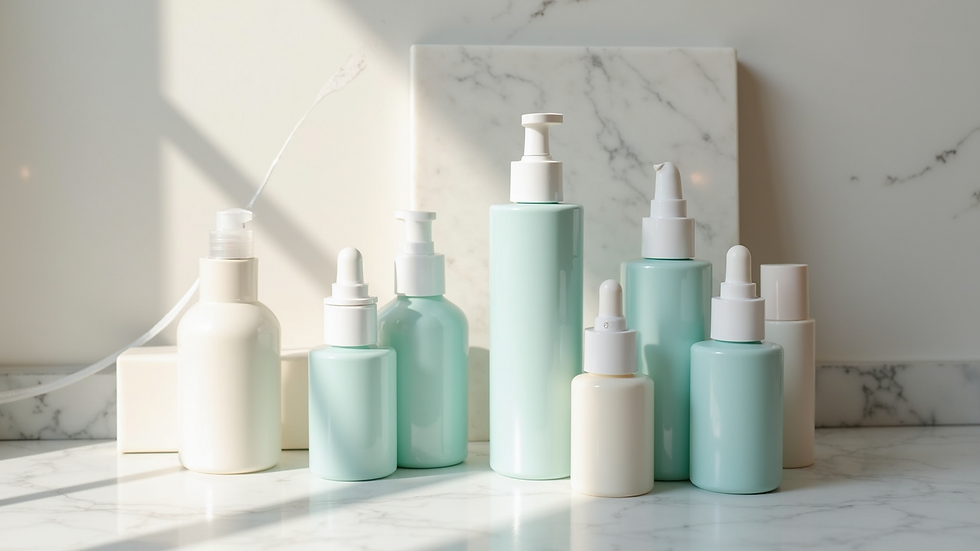The Power of Hyaluronic Acid & Peptides
- Danielle Kinkade
- Sep 19
- 4 min read
In the quest for youthful, radiant skin, two ingredients have emerged as true game-changers: hyaluronic acid and peptides. These powerful compounds work synergistically to hydrate, repair, and rejuvenate the skin, making them staples in many anti-aging skincare routines. Understanding how they function and how to use them effectively can transform your approach to skincare and deliver visible results.
Understanding Anti-Aging Skincare Solutions: Hyaluronic Acid and Peptides
Anti-aging skincare solutions often focus on hydration and collagen production, two key factors in maintaining skin elasticity and reducing wrinkles. Hyaluronic acid is a naturally occurring substance in the skin that holds moisture, keeping the skin plump and hydrated. Peptides, on the other hand, are short chains of amino acids that signal the skin to produce more collagen and elastin, essential proteins for skin firmness and resilience.
When combined, these ingredients complement each other perfectly. Hyaluronic acid provides deep hydration, creating an optimal environment for peptides to stimulate collagen synthesis. This combination helps reduce fine lines, improve skin texture, and restore a youthful glow.
Practical tip: Look for serums or moisturisers that contain both ingredients to maximise their benefits. Apply hyaluronic acid first on damp skin to lock in moisture, followed by peptide-rich products to boost collagen production.

How Hyaluronic Acid Works to Hydrate and Plump Skin
Hyaluronic acid is a humectant, meaning it attracts and retains water molecules. One gram of hyaluronic acid can hold up to six litres of water, making it incredibly effective at hydrating the skin. This hydration is crucial because as we age, the skin’s natural hyaluronic acid levels decrease, leading to dryness and the formation of wrinkles.
By replenishing hyaluronic acid through topical products, the skin regains its moisture balance, resulting in a plumper, smoother appearance. This hydration also helps to create a protective barrier, preventing moisture loss and environmental damage.
Example: Using a hyaluronic acid serum daily can visibly reduce the appearance of fine lines around the eyes and mouth within weeks. It is suitable for all skin types, including sensitive and acne-prone skin, because it is gentle and non-irritating.
Actionable recommendation: Apply hyaluronic acid products immediately after cleansing and toning, while your skin is still damp, to maximise absorption and hydration.

What Should I Never Mix with Hyaluronic Acid?
While hyaluronic acid is compatible with most skincare ingredients, there are a few combinations to avoid to prevent irritation or reduced effectiveness.
Avoid mixing with Vitamin C in the same layer: Vitamin C (ascorbic acid) is acidic and can lower the pH of hyaluronic acid, potentially reducing its hydrating properties. Instead, apply Vitamin C in the morning and hyaluronic acid in the evening or layer them separately with time gaps.
Be cautious with exfoliating acids: Ingredients like glycolic acid or salicylic acid can sometimes cause dryness or irritation when used with hyaluronic acid. If you use exfoliants, apply hyaluronic acid afterwards to soothe and hydrate the skin.
Avoid heavy oils immediately after: Applying thick oils right after hyaluronic acid can block its absorption. Use oils as the last step in your routine to seal in moisture.
Tip: Always patch test new combinations to ensure your skin reacts well.

The Role of Peptides in Skin Repair and Collagen Production
Peptides are small protein fragments that act as messengers in the skin. They signal cells to perform specific functions, such as producing collagen and elastin, which are vital for skin strength and elasticity. As we age, collagen production slows down, leading to sagging and wrinkles.
Incorporating peptides into your skincare routine can help reverse these signs of aging by stimulating collagen synthesis and promoting skin repair. Peptides also support the skin’s natural barrier, improving hydration and reducing inflammation.
Example: A peptide-rich cream applied consistently can improve skin firmness and reduce the depth of wrinkles over time. Some peptides also have antioxidant properties, protecting the skin from environmental stressors.
Actionable recommendation: Use peptide products twice daily after cleansing and toning. Combine with moisturisers to lock in hydration and enhance skin texture.
How to Incorporate Hyaluronic Acid and Peptides into Your Skincare Routine
To get the most out of your anti-aging skincare solutions, it’s important to use hyaluronic acid and peptides correctly. Here’s a simple step-by-step guide:
Cleanse: Start with a gentle cleanser to remove dirt and impurities.
Tone: Apply a hydrating toner to prepare your skin.
Apply Hyaluronic Acid: On damp skin, apply a hyaluronic acid serum to boost hydration.
Use Peptides: Follow with a peptide serum or cream to stimulate collagen production.
Moisturise: Seal in the active ingredients with a nourishing moisturiser.
Protect: In the morning, finish with a broad-spectrum sunscreen to protect against UV damage.
Consistency is key. Using these ingredients regularly will yield the best results over time.
For more detailed insights and product recommendations, check out this hyaluronic acid and peptides resource.
By understanding the unique benefits of hyaluronic acid and peptides, you can tailor your skincare routine to effectively combat the signs of aging. These ingredients work together to hydrate, repair, and rejuvenate your skin, helping you maintain a youthful, radiant complexion for years to come.



Comments